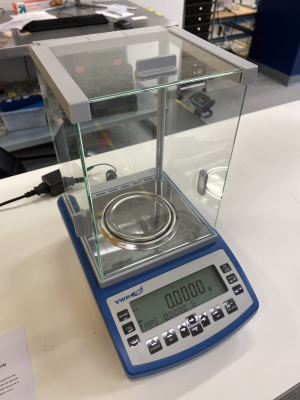Gravimetric Buoyancy
| VWR Analytical Balance [SOP] |
|---|
| Mass Range: 10mg - 160g |
| Precision: 0.1mg (0.0001g) |
The VWR Balances provide maximum weighing performance and are used for the accurate weighing of samples and precipitates. They are designed to measure small masses in the sub-milligram range. They are useful for determining density via the Archimedes method and can be used to take measurements over time. For example, they can be used to measure the rate at which a liquid evaporates.
Archimedes Method
The Archimedes method is used to determine the density of samples without needing to measure the sample’s physical dimensions. The difference in mass between the dry and submerged samples is equal to the volume of water displaced by the submerged sample because water has a density of ~1 gm/cm³. The density of the sample is found by taking the dry mass and dividing it by this volume. This method should only be used with samples that will not dissolve in water, as it will not work properly with water-soluble samples. The formula used is:
[math]\displaystyle{ \rho = \frac{m_d}{V} = \frac{m_d}{m_d-m_w} }[/math]
where [math]\displaystyle{ \rho }[/math] is density ([math]\displaystyle{ g/cm^3 }[/math]), [math]\displaystyle{ V }[/math] is volume, [math]\displaystyle{ m_d }[/math] is the dry mass, and [math]\displaystyle{ m_w }[/math] is the submerged ("wet") mass.
If a solvent other than water is used, or you need to take very precise density measurements based on liquid temperature, the formula becomes:
[math]\displaystyle{ \rho = \frac{m_d}{V} \frac{m_d}{m_d-m_w}*\rho_s }[/math]
where [math]\displaystyle{ \rho_s }[/math] is the density of the solvent.
